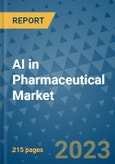The global AI in pharmaceutical market is on a robust growth trajectory, projected to reach an estimated valuation of US$4,451.6 million by the end of 2030. This market, which was valued at approximately US$807.2 million in 2018, is experiencing substantial growth, with a strong compound annual growth rate (CAGR) of 19.1% expected between 2023 and 2030.
Market Overview
AI in pharmaceuticals refers to the application of Artificial Intelligence (AI) technologies and techniques across various aspects of the pharmaceutical industry. AI is playing a pivotal role in accelerating drug discovery, reducing research and development costs, and improving patient outcomes by enabling data-driven decision-making, predictive modeling, and personalized treatment approaches.
Key Findings
- Rapid Market Growth: The global AI in pharmaceutical market is witnessing significant growth, with a projected valuation of US$4,451.6 million by 2030, compared to US$807.2 million in 2018.
- Key Growth Drivers: Factors driving this growth include the increasing adoption of AI in new drug discovery, advancements in AI technologies, and the demand for personalized treatments.
- Application in Drug Discovery: AI is revolutionizing drug discovery by accurately identifying disease patterns and optimizing drug compositions for various diseases. This is expected to lower R&D costs and accelerate research timelines.
- Natural Language Processing (NLP): NLP is a dominant technology segment in AI in pharmaceuticals. It helps extract valuable insights from unstructured text data, improving drug discovery and patient care.
Market Drivers
- New Drug Discovery: The pharmaceutical industry relies on AI to enhance the drug discovery process, reduce costs, and accelerate research timelines. Machine learning and AI can accurately identify disease patterns, leading to the development of affordable and effective drugs.
- Drug Discovery and Development: AI is being used to analyze vast datasets, identify potential drug targets, design drug molecules, predict drug efficacy and safety, and discover biomarkers, all of which accelerate the drug discovery and development process.
- Personalized Treatment: AI enables physicians to deliver personalized treatments by analyzing real-time patient data. This data-driven approach enhances diagnostic capabilities and improves patient outcomes.
Regional Growth
- North America: The United States is the largest investor in AI in the pharmaceutical industry, with substantial investments expected to reach US$6.3 billion by 2025. AI adoption in clinical trials, drug discovery, and drug development is propelling growth in North America.
- Asia Pacific: The Asia Pacific region, including countries like China, Japan, India, and South Korea, is experiencing the fastest growth in the AI in pharmaceutical market. AI adoption is accelerating drug discovery, precision medicine initiatives, and drug repurposing.
Competition Landscape
The AI in pharmaceutical market is competitive, with numerous companies and research institutions actively leveraging AI technologies. Key players in this market include GNS Healthcare, Benevolent AI, Berg Health, Novo Nordisk, IBM Corporation, Alphabet Inc (DeepMind), General Electric Company, Pfizer Inc., Johnson & Johnson, and Novartis AG.
Table of Contents
Companies Mentioned (Partial List)
A selection of companies mentioned in this report includes, but is not limited to:
- GNS Healthcare
- Benevolent AI
- Berg Health
- Novo Nordisk
- IBM Corporation
- Microsoft Corporation
- Alphabet Inc (DeepMind)
- General Electric Company
- Pfizer Inc
- Johnson & Johnson
- Novartis AG
- Bristol-Myers Squibb Company
Methodology

LOADING...








